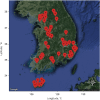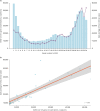National Wastewater Surveillance of SARS-CoV-2 Across Provinces and Regions in the Republic of Korea From January to August 2023
- PMID: 40762590
- PMCID: PMC12322592
- DOI: 10.3346/jkms.2025.40.e94
National Wastewater Surveillance of SARS-CoV-2 Across Provinces and Regions in the Republic of Korea From January to August 2023
Abstract
Background: Wastewater surveillance (WS) technology has gained significant attention in many countries due to its role in the monitoring of infectious diseases within communities and complementing clinical testing to prevent coronavirus disease 2019 (COVID-19) outbreaks. In 2023, the Korea Disease Control and Prevention Agency (KDCA) launched the Korea Wastewater Surveillance (KOWAS) project in collaboration with 17 cities and provinces to track COVID-19 outbreaks.
Methods: From January to August 2023, the concentrations of the severe acute respiratory syndrome coronavirus 2 (SARS-CoV-2) E gene in wastewater were monitored in 19 institutes of health and environmental research, all within local governments. Influent samples were collected from 62 wastewater treatment plants (WWTPs) and weekly trends in SARS-CoV-2 E gene concentrations in wastewater were compared to those of new COVID-19 cases.
Results: During 34 weeks, the concentration of SARS-CoV-2 in wastewater samples closely mirrored the trends in new COVID-19 cases, showing the effectiveness of WS in detecting the presence of the virus. However, the efficacy of the WS method varied between provinces. Although some provinces showed a significant positive correlation between new COVID-19 cases and SARS-CoV-2 E gene concentrations in wastewater, this correlation was inconsistent between all locations. However, when data were analyzed on a broader regional scale, defined as a grouping of multiple provinces, a higher proportion of regions showed significant correlations. This suggests that analyzing WS data on a broader scale, with larger aggregated populations and higher coverage rates, reduces the influence of local variabilities, such as the proportion of combined sewer types, WWTPs coverage rate, and foot traffic, which may affect alignment at the provincial level.
Conclusion: The synchrony between trends in SARS-CoV-2 E gene concentrations in wastewater and new COVID-19 cases highlights the effectiveness of KOWAS in tracking new clinical cases. However, measured SARS-CoV-2 RNA concentrations can be affected by socioenvironmental factors (e.g., WWTP treatment capacity, sewer pipeline distances, and coverage populations). Further refinement will involve expanding the surveillance network to include additional WWTPs and a more comprehensive range of monitoring targets.
Keywords: COVID-19; KOWAS; Republic of Korea; SARS-CoV-2; Wastewater Surveillance.
© 2025 The Korean Academy of Medical Sciences.
Conflict of interest statement
The authors have no potential conflicts of interest to disclose.
Figures






Similar articles
-
Hospital wastewater surveillance for SARS-CoV-2 identifies intra-hospital dynamics of viral transmission and evolution.Appl Environ Microbiol. 2025 Jul 23;91(7):e0050125. doi: 10.1128/aem.00501-25. Epub 2025 Jul 1. Appl Environ Microbiol. 2025. PMID: 40590566 Free PMC article.
-
The effect of sample site and collection procedure on identification of SARS-CoV-2 infection.Cochrane Database Syst Rev. 2024 Dec 16;12(12):CD014780. doi: 10.1002/14651858.CD014780. Cochrane Database Syst Rev. 2024. PMID: 39679851 Free PMC article.
-
Measures implemented in the school setting to contain the COVID-19 pandemic.Cochrane Database Syst Rev. 2022 Jan 17;1(1):CD015029. doi: 10.1002/14651858.CD015029. Cochrane Database Syst Rev. 2022. Update in: Cochrane Database Syst Rev. 2024 May 2;5:CD015029. doi: 10.1002/14651858.CD015029.pub2. PMID: 35037252 Free PMC article. Updated.
-
Rapid, point-of-care antigen tests for diagnosis of SARS-CoV-2 infection.Cochrane Database Syst Rev. 2022 Jul 22;7(7):CD013705. doi: 10.1002/14651858.CD013705.pub3. Cochrane Database Syst Rev. 2022. PMID: 35866452 Free PMC article.
-
Identification of sentinel upstream community sites for wastewater surveillance of SARS-CoV-2 in a large urban area.Water Res. 2025 Sep 15;284:123958. doi: 10.1016/j.watres.2025.123958. Epub 2025 Jun 17. Water Res. 2025. PMID: 40532560
References
MeSH terms
Substances
Grants and funding
LinkOut - more resources
Full Text Sources
Medical
Miscellaneous

